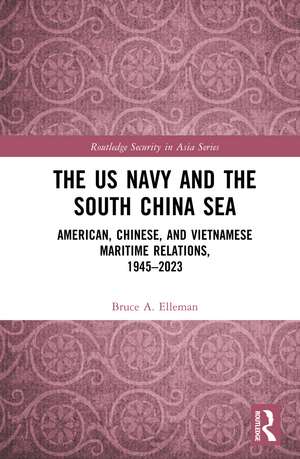The US Navy and the South China Sea: American, Chinese, and Vietnamese Maritime Relations, 1945-2023: Routledge Security in Asia Series
Autor Bruce A Ellemanen Limba Engleză Hardback – 13 aug 2024
Preț: 950.08 lei
Preț vechi: 1158.63 lei
-18% Nou
Puncte Express: 1425
Preț estimativ în valută:
181.80€ • 190.68$ • 151.34£
181.80€ • 190.68$ • 151.34£
Carte tipărită la comandă
Livrare economică 01-15 aprilie
Preluare comenzi: 021 569.72.76
Specificații
ISBN-13: 9781032824079
ISBN-10: 1032824077
Pagini: 284
Ilustrații: 26
Dimensiuni: 156 x 234 mm
Greutate: 0.58 kg
Ediția:1
Editura: Taylor & Francis
Colecția Routledge
Seria Routledge Security in Asia Series
Locul publicării:Oxford, United Kingdom
ISBN-10: 1032824077
Pagini: 284
Ilustrații: 26
Dimensiuni: 156 x 234 mm
Greutate: 0.58 kg
Ediția:1
Editura: Taylor & Francis
Colecția Routledge
Seria Routledge Security in Asia Series
Locul publicării:Oxford, United Kingdom
Public țintă
AcademicCuprins
Acronym List
List of Figures
Introduction: Evaluating the South China Sea’s Maritime Challenges
1) The Early Chinese and European Influence on a Divided Vietnam
2) The Sino-Soviet Alliance and its 1960 Split
3) The U.S. Enters the Vietnam War, 1960-1969
4) Using the Vietnam War to Start a Sino-Soviet War, 1969
5) President Richard Nixon Opens Diplomatic Relations with the PRC, 1969-1972
6) The PLAN Invasion of the Paracels, 1974
7) The Sino-Vietnamese War of 1979 and the End of the Sino-Soviet Monolith
8) Sino-U.S. Cooperation against Vietnam and the USSR and the End of the Cold War
Conclusions: The Possible Formation of a U.S.-Vietnamese anti-Chinese Alliance
Timeline
Document 1: Sino-French Tonkin Treaty, 26 June 1887
Document 2: Cairo Declaration, 1 December 1943
Document 3: Potsdam Proclamation, 26 July 1945
Document 4: Treaty of Peace with Japan, 8 September 1951
Document 5: Treaty of Peace between the Republic of China and Japan, 28 April 1952
Document 6: U.S.-ROC Mutual Defense Treaty, 2 December 1954 (ratified 1955) plus Secret Protocol
Document 7: Formosa Resolution, 1955
Document 8: Declaration on China’s Territorial Sea, 4 September 1958
Document 9: Prime Minister Pham Van Dong’s Letter, 14 September 1958
Document 10: Shanghai Communiqué, 28 February 1972
Document 11: Joint Communiqué on the Establishment of Diplomatic Relations between the
People’s Republic of China and the United States of America, 16 December 1978
Document 12: Taiwan Relations Act, 10 April 1979
Document 13: Joint Communiqué on the Question of Arms Sales to Taiwan, 17 August 1982
Document 14: Law on the Territorial Sea and the Contiguous Zone, 25 February 1992
Document 15: 1992 ASEAN Declaration on the South China Sea, 22 July 1992
Document 16: United Nations Convention on the Law of the Sea, PART V, Exclusive Economic Zone, In force since 14 November 1994
Document 17: A concurrent resolution expressing the sense of Congress regarding missile tests
and military exercises by the People's Republic of China, 21 March 1996.
Document 18: Law on the Exclusive Economic Zone and the Continental Shelf of the PRC, 26 June 1998
Document 19: 2002 Declaration on the Conduct of Parties in the South China Sea,
4 November 2002
Document 20: Anti-Secession Law adopted by NPC, 14 March 2005
Document 21: Cross-Straits Economic Cooperation Framework Agreement, 29 June 2010
Document 22: In the Matter of the South China Sea Arbitration, 12 July 2016
Selected Bibliography
Biography
List of Figures
Introduction: Evaluating the South China Sea’s Maritime Challenges
1) The Early Chinese and European Influence on a Divided Vietnam
2) The Sino-Soviet Alliance and its 1960 Split
3) The U.S. Enters the Vietnam War, 1960-1969
4) Using the Vietnam War to Start a Sino-Soviet War, 1969
5) President Richard Nixon Opens Diplomatic Relations with the PRC, 1969-1972
6) The PLAN Invasion of the Paracels, 1974
7) The Sino-Vietnamese War of 1979 and the End of the Sino-Soviet Monolith
8) Sino-U.S. Cooperation against Vietnam and the USSR and the End of the Cold War
Conclusions: The Possible Formation of a U.S.-Vietnamese anti-Chinese Alliance
Timeline
Document 1: Sino-French Tonkin Treaty, 26 June 1887
Document 2: Cairo Declaration, 1 December 1943
Document 3: Potsdam Proclamation, 26 July 1945
Document 4: Treaty of Peace with Japan, 8 September 1951
Document 5: Treaty of Peace between the Republic of China and Japan, 28 April 1952
Document 6: U.S.-ROC Mutual Defense Treaty, 2 December 1954 (ratified 1955) plus Secret Protocol
Document 7: Formosa Resolution, 1955
Document 8: Declaration on China’s Territorial Sea, 4 September 1958
Document 9: Prime Minister Pham Van Dong’s Letter, 14 September 1958
Document 10: Shanghai Communiqué, 28 February 1972
Document 11: Joint Communiqué on the Establishment of Diplomatic Relations between the
People’s Republic of China and the United States of America, 16 December 1978
Document 12: Taiwan Relations Act, 10 April 1979
Document 13: Joint Communiqué on the Question of Arms Sales to Taiwan, 17 August 1982
Document 14: Law on the Territorial Sea and the Contiguous Zone, 25 February 1992
Document 15: 1992 ASEAN Declaration on the South China Sea, 22 July 1992
Document 16: United Nations Convention on the Law of the Sea, PART V, Exclusive Economic Zone, In force since 14 November 1994
Document 17: A concurrent resolution expressing the sense of Congress regarding missile tests
and military exercises by the People's Republic of China, 21 March 1996.
Document 18: Law on the Exclusive Economic Zone and the Continental Shelf of the PRC, 26 June 1998
Document 19: 2002 Declaration on the Conduct of Parties in the South China Sea,
4 November 2002
Document 20: Anti-Secession Law adopted by NPC, 14 March 2005
Document 21: Cross-Straits Economic Cooperation Framework Agreement, 29 June 2010
Document 22: In the Matter of the South China Sea Arbitration, 12 July 2016
Selected Bibliography
Biography
Notă biografică
Bruce A. Elleman is William V. Pratt Professor of International History at the US Naval War College in Newport, Rhode Island, USA
Descriere
This book explores the question “Why is the US Navy in the South China Sea at all?” It traces the history of diplomatic, economic, and military tensions among the People’s Republic of China, the Soviet Union, the United States, and the Socialist Republic of Vietnam.
















